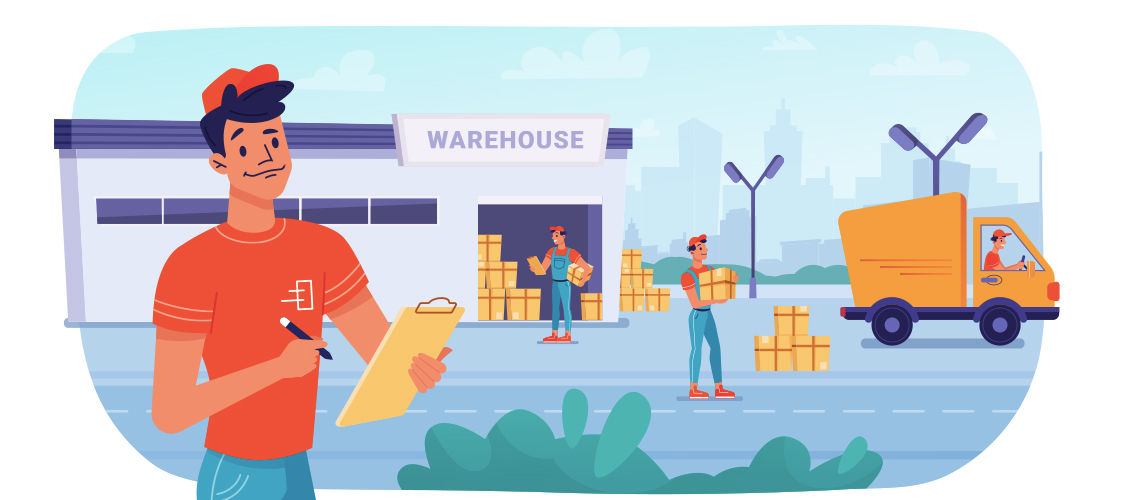eCommerce shipping is a kind of service that transports products, sold via an eCommerce business. These products are shipped from one place to another to the customer’s doorstep. eCommerce shipping covers the overall business aspect of providing the best in class customer experience while delivering a product. What is the right way to ship your products hassle-free? Continue reading to understand, How does eCommerce Shipping Work?

How Does eCommerce Shipping Work?
When you want to create an online store, one of the first things that you think of what you want to sell, how much do you want to sell it for, what logistics model to choose? etc.
Making the product can be something that you decide to make yourself or another way to go about with this would be to stock someone else’s product. Inventory and Delivery will need outsourcing as it is impossible for an individual to manage this independent of external help.
Different models to make this process easy and time-efficient. Depending on how much time you can devote and the availability of resources for product manufacturing you can choose a model that is most suitable for your business.
Working of e-commerce Shipping
A eCommerce shipping company functions in two directions:
Forward Direction
Forward logistics are used to manage the forward movement of goods and raw material to the consumer. As the product passes through each step along its route, value is added to it till it reaches its end user. Forward direction of eCommerce shipping can become more contrasting the further away they are from raw materials. In simple words, while raw material can often be found only in a rare few places, end products must get into the homes of places of business every customer.
The rate of forwarding shipping is dictated by customer demand and inventory is kept at each stage to manage variances in that demand. For an e-commerce company in the forward-moving direction, it involves the following steps:
- Receiving an online order
- Arranging for the required product
- Packaging, preparing its invoice
- Arranging for payments, dispatching
- Delivering the item to the customer
Reverse Direction
Reuse of products and materials is not a new concept, waste paper recycling, deposit systems for System for soft drink bottles, etc. However, reverse logistics as a research field is relatively new. Reverse logistics is gaining popularity in recent years. More and more companies are starting to understand the importance of reverse logistics.
Reverse logistics is often looked down upon and quite often viewed as an expensive and recurring headache. Reverse logistics poses one of the biggest operational challenges in the world of e-commerce, due to the sheer volume and cost of processing returns that one has to incur.
Both these processes become easy if eCommerce shipping is managed, controlled, and taken care of by an e-commerce company.
Shipping strategies for your eCommerce business
Setting a foundation for your shipping procedure is the first step to having a smooth and faultless shipping system. There are a few basic steps that should be incorporated, these key decisions make up for a high-level shipping strategy.
Deciding shipping rates and methods
Asking yourself, “Am I going to pass on the complete cost of shipping to my customers, or am I willing to offer free or flat-rate shipping to my customers?” is the first step in getting more information to decide what methods you want to involve in your business.
You can offer free shipping (absorbs all of the cost or flat-rate shipping (absorb some of the cost) that your customer is going to bear. This makes it easier to make appropriate choices for your business.
Consider the weight of the product
Measure and update the weight of each product that you sell to streamline the shipping process. This gives you a good sense of the total cost which assists in providing accurate p to your customers.
Suitable packaging
This goes without saying that you need to decide what kind of packaging is befitting to your product. For eg. You cannot pack a glass vase in a brown paper bag. You need to understand the requirements of the security of your product.
Confirm the shipping destination
The next step is to confirm where your package has to be shipped. Finalizing the destination is important as it also plays a deciding factor in how much shipping of a specific product will cost you. The farther the destination is, the more the charges will increase.
Source your shipping carrier
Once you’ve established the above steps, all you have to do is find a suitable shipping carrier. This is the final call that you have to take. Compare different carrier services and find that meets your requirements.
How to set your shipping rates and methods?
It is essential to decide your pricing strategy for shipping before you can ship products. There are several common methods, but your choice solely depends on the underlying financials of your business.
Free shipping
Not very true to its name, free shipping is not actually free. Someone has to bear the cost of it, and that someone will be you. This is one of the best ways to lessen the shopping cart abandonment. Here are a few ways to make free shipping work.
Increasing the pricing of the product. This way the customer bears the cost of shipping. You pay the full price of shipping out the product out of your margins. Here, only you will be paying for the shipping.
Increasing the price of the products slightly to cover partial costs of shipping. You and your customer share the cost incurred for shipping. Offering a discount code to certain customers for free shipping. This also draws attention to your business.
Charge real-time carrier rates
Charging real-time carrier rates for shipping is another effective shipping strategy. There are a lot of e-commerce platforms like Shopify that are integrated in real-time with several carriers to generate live pricing and shipping options from different carriers. This gives your customer the liberty to choose and pay for the exact service that they need according to their requirements.
Charging a flat-rate
Flat-rate shipping is another popular alternative. The best practice for this is to make sure that you don’t undercharge or overcharge your customers. For this, it is important to understand a fairly standard product line of items that have similar sizes and weights to your product. There are a lot of shipping calculators available online that help you to do this easily.
eCommerce Logistics and Shipping Models
The term “eCommerce model” might sound very complicated at first. But once you go ahead and understand the concept it’s nothing more than the action that one undertakes to stock and sell products in their store.
There are 3 main eCommerce business models:
Warehouse model
The warehouse model, also known as the wholesaling model requires a lot of storage place and dedicated software to manage the supply chain and order fulfillment. With this model, one expects to buy the product directly from the manufacturer at a lower price, stock inventory in your warehouse, and ship the product when the client places an order. Products should have a consistent flow of demand so that the products are not just sitting in inventory.
Fulfillment
Ecommerce fulfillment may not be something that gets you excited about your online business. However, it is a key element of your success in online retail. Hence, it is the part of your online business that delivers your products to customers. Ecommerce fulfillment has been an integral part of your business right from the start. You were your fulfillment provider when you were packing boxes. After your business has grown, it becomes important to outsource your fulfillment to a third-party logistics company.

Dropshipping
This is the easiest to manage logistic model, where you don’t have to worry about the manufacturing or the delivery of the product. Any online store that chooses this method is only the mediator between the manufacturer and the client. Hence, supplier stocks the products in the inventory and then carries out the shipping. The most difficult part of this model is finding the right company to work with.
Choosing this model means losing control over the manufacturing and delivering the product, the reputation of your store is in your hands as well as in the hands of the company that you choose. This model works best for entrepreneurs who don’t have many resources to invest in manufacturing and storing products. Due to the simplicity of this model, the competition is huge and the margins are not very high. However, the dropshipping model creates a low maintenance business that can be profitable with the right promotion.
Now that you know about the three models, go ahead and decide which one is the most suitable model for your online business.
Dash101, is the your effective shipping solution to consider. It offers free subscription, a user-friendly order creation, seamless shipping logistics service, reverse logistics, bulk shipping, COD, prepaid payment options, secured delivery service and tracking in real-time.
Shipping cost at Dash101 starts at very competitive rates and the expedited delivery through our shipping carrier integrations, sellers can securely send a parcel to 26,000+ pin codes across India.







Leave a Review